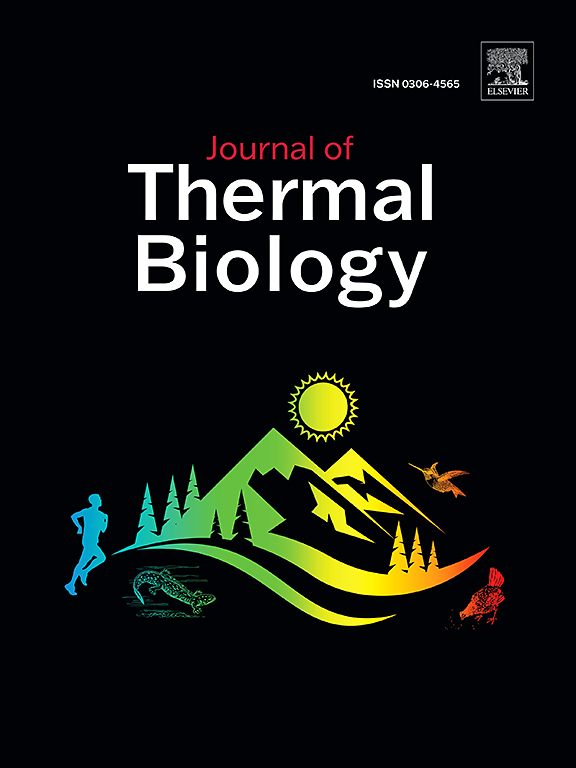大型森林犀鸟喙和壳的非蒸发散热。
IF 2.9
2区 生物学
Q2 BIOLOGY
引用次数: 0
摘要
鸟类,尤其是巨嘴鸟(Ramphastidae)和犀鸟(Bucerotidae)等大嘴类群,通过鸟喙散失热量是一种重要的体温调节机制。研究的物种数量仍然有限,我们对这一途径的功能意义如何随环境变量(如湿度)而变化的理解也有限,以前对栖息在潮湿环境中的物种的研究很少。我们使用红外热成像技术来验证大型(600-1300 克)非洲热带森林犀鸟将其喙和壳作为热辐射器的假设。我们收集了野生捕获的号角犀鸟(Bycanistes bucinator)、人工饲养的银颊犀鸟(Bycanistes brevis)和黑颊犀鸟(Ceratogymna atrata)在15-34 °C气温(Tair)范围内的数据。喙和壳的表面温度(Tbeak)在低于24-25 °C时跟踪Tair,但在Tair较高时,Tbeak-Tair梯度增加到最大值10-12 °C。喙的最大热损失率为 2.5-3.8 W,相当于静止代谢产热估计值的 31-83%。面部皮肤也显示出热量损失的主动调节。我们还结合已发表的数据和三个未发表的数值,分析了Tbeak - Tair梯度增加时的拐点Tair(Tinflection)的比例。我们发现,Tinflection 随着体重(Mb)的增加而减少,其关系用线性回归模型 Tinflection = -9.134log10Mb + 50.83(Mb 单位为 g)来描述最为恰当。本文章由计算机程序翻译,如有差异,请以英文原文为准。
Non-evaporative heat dissipation across the beaks and casques of large forest hornbills
Heat loss across the beak is an important thermoregulatory mechanism among birds, particularly in large-beaked taxa such as toucans (Ramphastidae) and hornbills (Bucerotidae). The number of species investigated remains limited, as does our understanding of how the functional significance of this pathway varies with environmental variables such as humidity, with little previous research on species inhabiting humid environments. We used infrared thermography to test the hypothesis that large (600–1300 g) Afrotropical forest hornbills use their beaks and casques as thermal radiators. We collected data over air temperatures (Tair) of 15–34 °C for wild-caught trumpeter hornbills (Bycanistes bucinator) and captive-bred silvery-cheeked hornbills (Bycanistes brevis) and black-casqued hornbills (Ceratogymna atrata). Surface temperatures of the beaks and casques (Tbeak) tracked Tair below 24–25 °C, but at higher Tair, the Tbeak – Tair gradient increased to maximum values of 10–12 °C. Maximum rates of beak heat loss were 2.5–3.8 W, equivalent to 31–83 % of estimated resting metabolic heat production. Facial skin showed also evidence for active regulation of heat loss. We also analysed the scaling of the inflection Tair above which the Tbeak – Tair gradient increases (Tinflection) by combining our data with published and three unpublished values. We found that Tinflection decreases with increasing body mass (Mb), with the relationship best described by the linear regression model Tinflection = −9.134log10Mb + 50.83, with Mb in g.
求助全文
通过发布文献求助,成功后即可免费获取论文全文。
去求助
来源期刊

Journal of thermal biology
生物-动物学
CiteScore
5.30
自引率
7.40%
发文量
196
审稿时长
14.5 weeks
期刊介绍:
The Journal of Thermal Biology publishes articles that advance our knowledge on the ways and mechanisms through which temperature affects man and animals. This includes studies of their responses to these effects and on the ecological consequences. Directly relevant to this theme are:
• The mechanisms of thermal limitation, heat and cold injury, and the resistance of organisms to extremes of temperature
• The mechanisms involved in acclimation, acclimatization and evolutionary adaptation to temperature
• Mechanisms underlying the patterns of hibernation, torpor, dormancy, aestivation and diapause
• Effects of temperature on reproduction and development, growth, ageing and life-span
• Studies on modelling heat transfer between organisms and their environment
• The contributions of temperature to effects of climate change on animal species and man
• Studies of conservation biology and physiology related to temperature
• Behavioural and physiological regulation of body temperature including its pathophysiology and fever
• Medical applications of hypo- and hyperthermia
Article types:
• Original articles
• Review articles
 求助内容:
求助内容: 应助结果提醒方式:
应助结果提醒方式:


